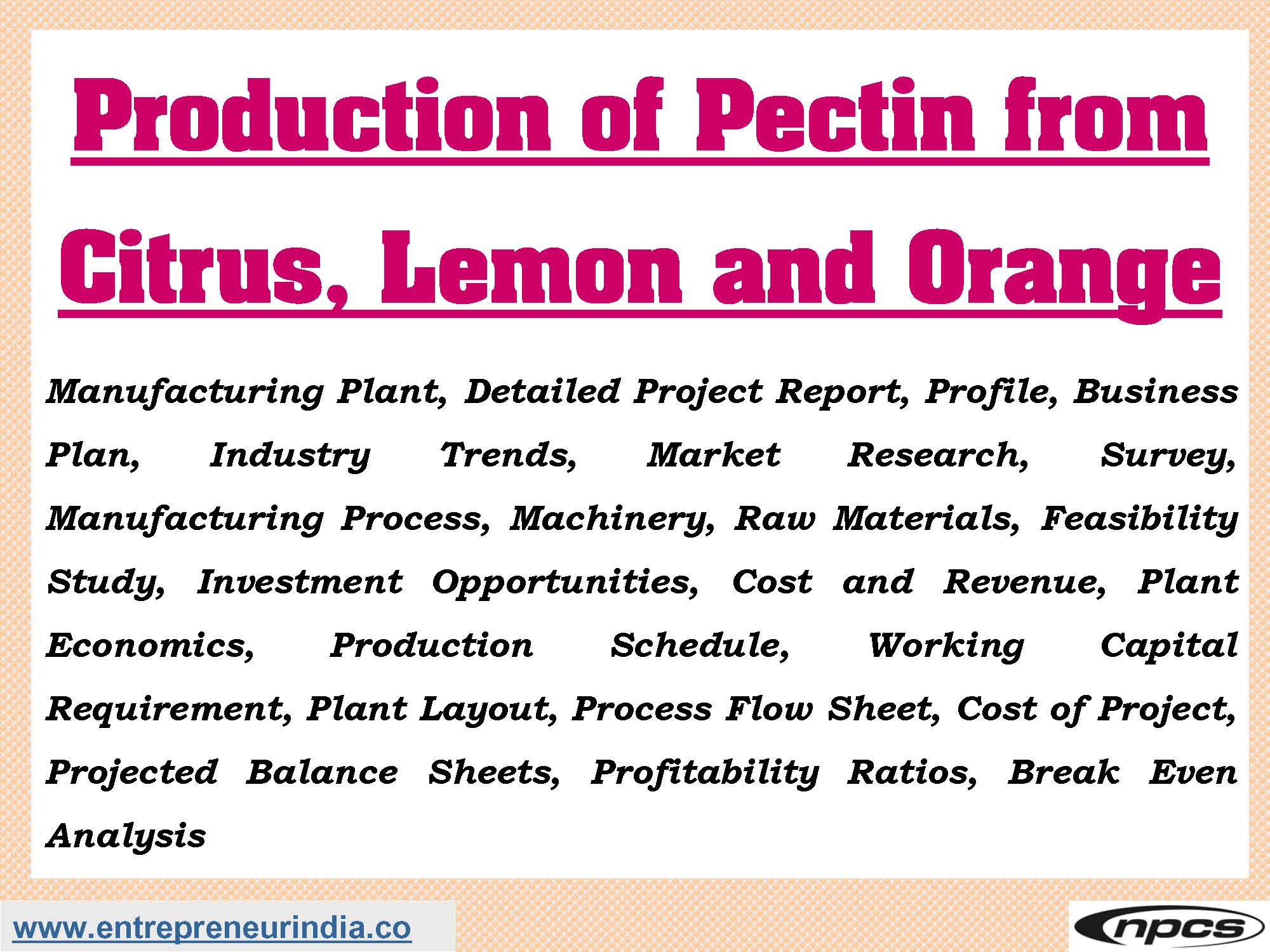
Pectin is a plant-based fiber commonly found in citrus fruits like oranges, lemons, and limes. It is widely used in the food, pharma, and cosmetic industries. From jams and jellies to health supplements and skin products, pectin plays a key role as a gelling and stabilizing agent. As consumer demand for clean-label and natural products grows, pectin production from citrus waste offers a profitable and eco-friendly business opportunity. Moreover, with India’s thriving fruit processing industry, there’s no shortage of raw materials for pectin extraction.
Pectin Production from Citrus | Plant Setup & DPR Guide
Starting a pectin production business involves processing citrus peels into high-quality pectin powder. The setup requires chemical extraction equipment, alcohol handling systems, and drying facilities. This industry is highly scalable and offers excellent returns. Moreover, it supports waste reduction and circular economy goals by turning peel waste into a valuable commercial product.
See Also :Manufacturing & Processing Ideas in Odisha
What Is Pectin?
Pectin is a natural carbohydrate found in the cell walls of fruits, especially citrus and apples. It forms gels in the presence of sugar and acid, making it ideal for:
-
Jams and fruit preserves
-
Yogurt and desserts
-
Dietary fiber supplements
-
Fat replacers in baked goods
-
Cosmetic formulations
Moreover, pectin is vegan, non-allergenic, and increasingly in demand across health-conscious markets.
Raw Materials for Pectin Production
The main source for pectin production is citrus peel waste. You can collect peels from juice plants, canneries, and fruit processing units. Common sources include:
-
Oranges
-
Lemons
-
Limes
-
Grapefruit
-
Sweet lime (mosambi)
Other inputs include:
-
Water
-
Food-grade acids (hydrochloric or nitric acid)
-
Ethanol or isopropyl alcohol
-
Basic salts for pH balancing
Moreover, apple pomace can be used as a secondary source in areas with low citrus availability.
Pectin Extraction Process
The process of pectin production includes the following steps:
-
Drying and Grinding
Dry the citrus peel using tray or rotary dryers. Then grind it into small particles. -
Acid Extraction
Mix the peel with acidified hot water (pH 1.5 to 3) and heat at 80–90°C. This releases the pectin. -
Filtration
Filter the mixture to separate solids from the pectin-rich liquid. -
Precipitation
Add alcohol to the extract. This causes pectin to gel and separate from the liquid. -
Washing and Drying
Wash the pectin mass to remove residues, then dry it in a vacuum or hot air dryer. -
Grinding and Packaging
Grind the dry pectin into powder and package it in moisture-proof containers.
Moreover, using ethanol recovery systems can reduce waste and save money in large-scale operations.
Machines Needed for Pectin Production
Setting up a plant requires:
-
Peel washers and dryers
-
Pulverizers
-
Stainless steel extraction tanks
-
Heat exchangers
-
Alcohol tanks and recovery units
-
Filtration system
-
Drying system (fluid bed or vacuum dryer)
-
Packaging machines
Moreover, maintaining food-grade hygiene is crucial at every stage to meet FSSAI standards.
Plant Layout and Zoning
A clean, well-zoned facility ensures smooth operation and product quality. Divide your unit into:
-
Raw material storage
-
Extraction and precipitation area
-
Drying and grinding zone
-
Packaging section
-
Quality control lab
Moreover, alcohol-handling areas should follow safety norms like flameproof fittings and proper ventilation.
Legal Requirements and Certifications
To run a pectin production plant in India, you need:
-
FSSAI License (as food additive manufacturer)
-
Pollution Control Board approvals
-
Factory License and Fire Safety NOC
-
GST and MSME registration
-
Import-Export Code (if selling overseas)
Moreover, compliance with BIS and Codex standards is needed for exports and B2B sales.
Investment and Profit Estimate
Here is a breakdown of setup costs and expected profits:
| Plant Capacity | Setup Cost (?) | Monthly Profit (?) |
|---|---|---|
| Small (500 kg/day) | ?35–?50 lakh | ?1.5–?2.5 lakh |
| Medium (1 ton/day) | ?1–?1.5 crore | ?4–?6 lakh |
| Large (5+ tons/day) | ?2–?4 crore+ | ?10–?15 lakh+ |
Moreover, pectin sells at a premium, especially if it’s pharma or food-grade certified.
Market Demand and Buyers
Global demand for pectin is growing. Key markets include:
-
Food processing companies
-
Jam and jelly brands
-
Dairy product manufacturers
-
Pharma and nutraceutical firms
-
Exporters and ingredient wholesalers
Moreover, the clean-label trend is pushing both global and Indian companies to switch to natural additives like pectin.
Packaging and Branding
Use air-tight and moisture-proof packaging to preserve shelf life. Common options:
-
500g to 1kg retail pouches
-
25kg HDPE-lined drums (for bulk buyers)
-
Vacuum-sealed food-grade containers
Moreover, branding your pectin as “natural,” “vegan,” or “clean-label” can increase appeal in premium segments.
Read Also :Profitable Manufacturing & Processing Ideas in Himachal
Conclusion
Pectin Production from citrus waste is a high-value, sustainable business idea with enormous global and domestic potential. With low-cost raw materials, well-established extraction technology, and growing market demand, this venture offers both profitability and environmental benefits. Moreover, with government support for agro-processing and waste utilization, setting up a pectin plant can position you as a leader in functional ingredient manufacturing.



